
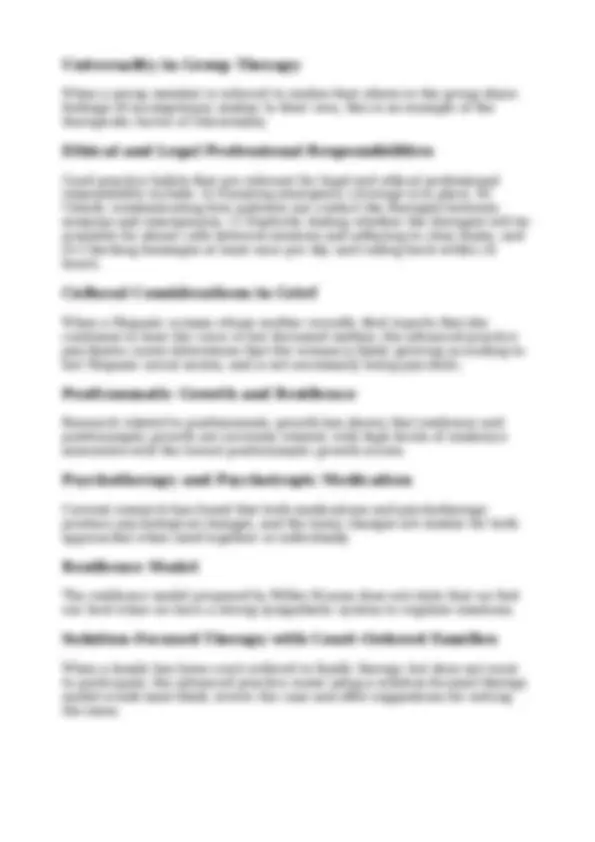
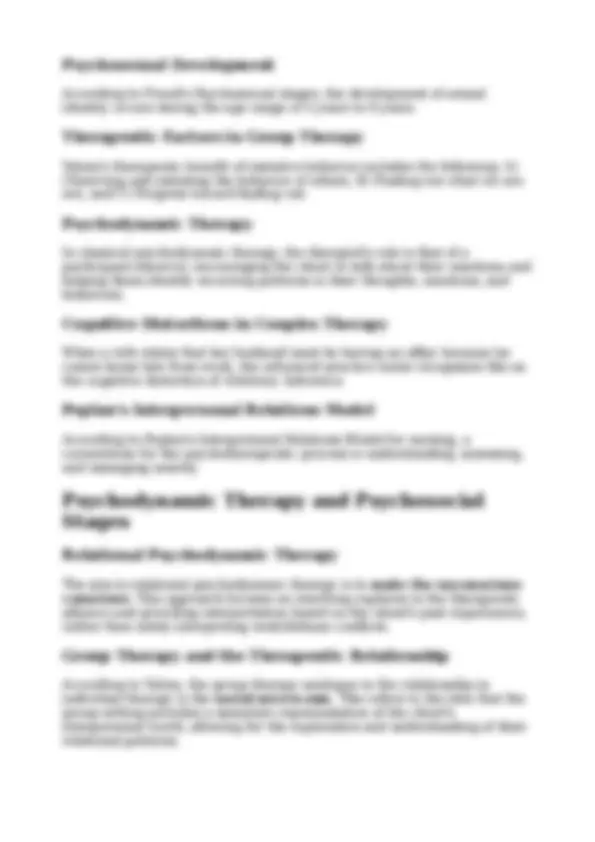
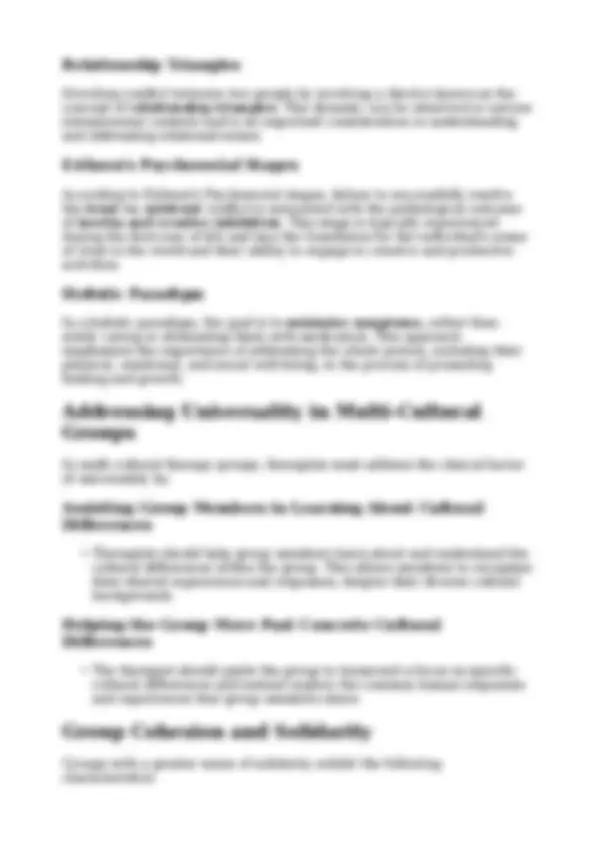
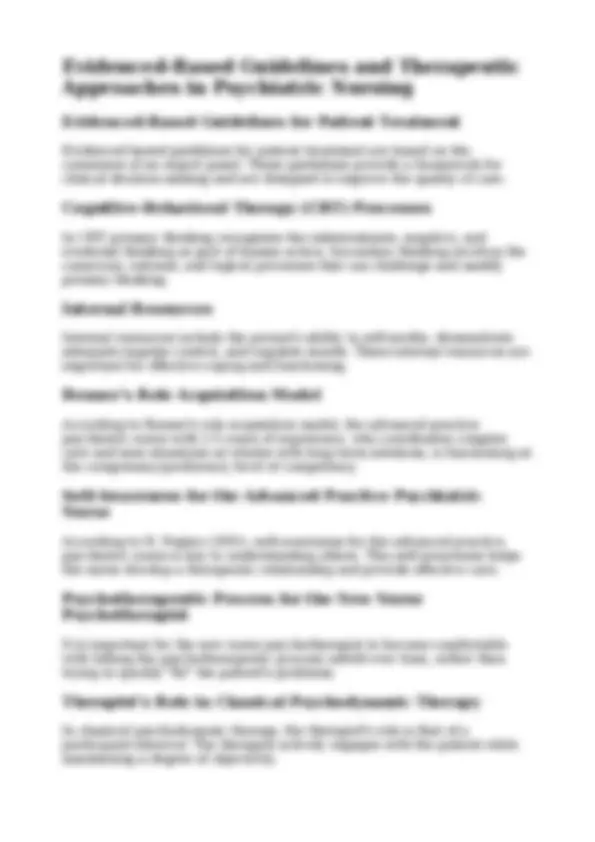
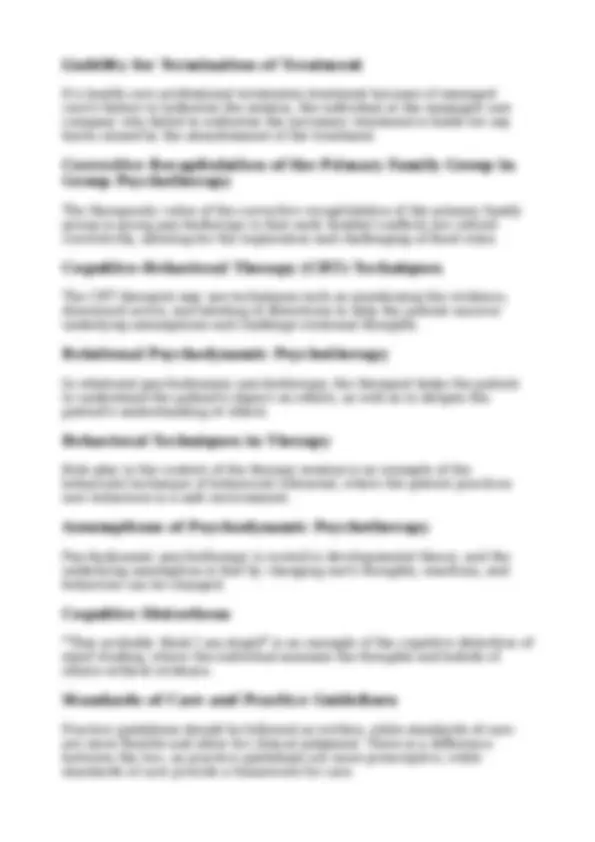
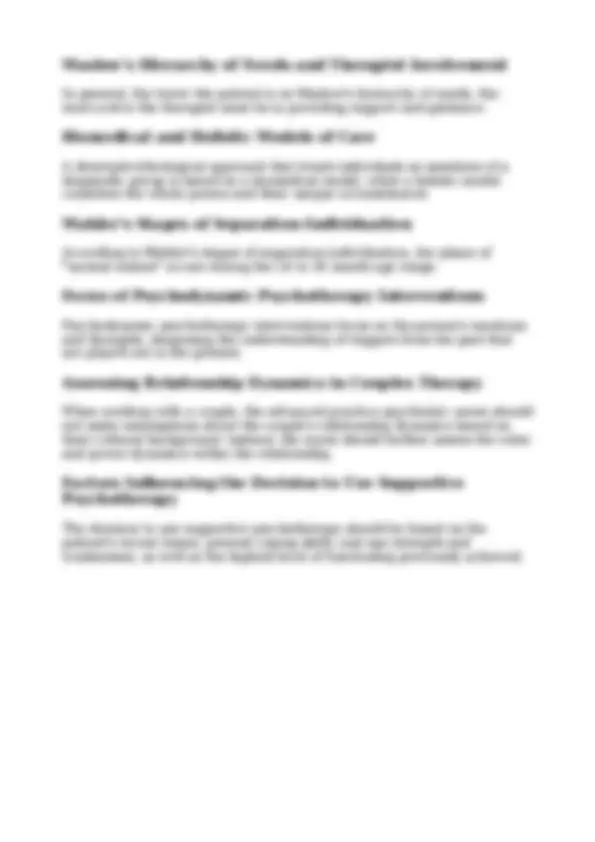


Study with the several resources on Docsity

Earn points by helping other students or get them with a premium plan


Prepare for your exams
Study with the several resources on Docsity

Earn points to download
Earn points by helping other students or get them with a premium plan
Community
Ask the community for help and clear up your study doubts
Discover the best universities in your country according to Docsity users
Free resources
Download our free guides on studying techniques, anxiety management strategies, and thesis advice from Docsity tutors
A comprehensive overview of key strategies and techniques used in psychiatric nursing practice. It explores various therapeutic approaches, including dynamic supportive therapy, cognitive behavioral therapy (cbt), psychodynamic psychotherapy, and structural family therapy. The document also delves into important concepts such as suicide assessment, cultural influences in families, and ethical and legal professional responsibilities. It further examines therapeutic factors in group therapy, object relations theory, and the importance of addressing universality in multicultural groups. Valuable for students and professionals seeking to enhance their understanding of psychiatric nursing practice.
Typology: Exams
1 / 10

This page cannot be seen from the preview
Don't miss anything!







The advanced practice psychiatric nurse may intervene as appropriate with agencies or persons in order to advocate for the patient, and do for the patient what they cannot do for themselves. This is done with the aim of maximizing the patient's independence and growth, which is consistent with the basic strategy of dynamic supportive therapy.
Assessing the patient is of paramount importance for the advanced practice psychiatric nurse during the initial patient contact. Suicidality can be assessed by using reliable and valid self-report questionnaires.
Common ancestry through which individuals have evolved shared values and customs is known as ethnicity.
In a CBT approach, the therapist encourages the patient to investigate whether their thoughts are based on facts or assumptions. This is known as "Questioning the Evidence".
Psychodynamic psychotherapy does not assume that what happened in the past determines what we do today. This is not consistent with the underlying assumptions of this approach.
When a patient is in the process of an unwanted divorce, endorses persistent suicidal ideations with strong intent, the advanced practice psychiatric nurse recognizes the patient is at high suicide risk and recommends hospital psychiatric admission and suicide precautions.
The cultural context of families is complicated by the fact that most families are influenced by multiple contexts. The therapist should be safe in making this assumption about cultural influences in a family.
The CBT therapist asking the patient to rate their depression on a scale of 0-10 and compare it to 2 months ago would not be a question consistent with Socratic Dialogue.
Standards of care are legally binding, while practice guidelines are not.
Restructuring is a strategy for working with anxiety that would be consistent with a behavioral therapy approach.
Cognitive Behavioral Therapy (CBT) is consistent with the following: A) Identifying and modifying maladaptive thoughts and beliefs, and B) Behavioral experiments to test the validity of thoughts.
In the Structural Family Therapy model, family structure refers to the way families are organized into subsystems separated by emotional boundaries.
"They probably think I am stupid" is an example of the cognitive distortion known as "Mind reading".
In therapy groups where group members gain through receiving help from group members and giving help to group members, the therapeutic benefit of Altruism is being realized.
When a group member becomes angry with the group leader, accusing the leader of being too controlling and showing favoritism, this behavior is consistent with the therapeutic factor of Catharsis.
According to Freud's Psychosexual stages, the development of sexual identity occurs during the age range of 3 years to 6 years.
Yalom's therapeutic benefit of imitative behavior includes the following: A) Observing and imitating the behavior of others, B) Finding out what we are not, and C) Progress toward finding out.
In classical psychodynamic therapy, the therapist's role is that of a participant-observer, encouraging the client to talk about their emotions and helping them identify recurring patterns in their thoughts, emotions, and behaviors.
When a wife states that her husband must be having an affair because he comes home late from work, the advanced practice nurse recognizes this as the cognitive distortion of Arbitrary Inference.
According to Peplau's Interpersonal Relations Model for nursing, a cornerstone for the psychotherapeutic process is understanding, assessing, and managing anxiety.
Psychodynamic Therapy and Psychosocial
Stages
The aim in relational psychodynamic therapy is to make the unconscious conscious. This approach focuses on resolving ruptures in the therapeutic alliance and providing interpretation based on the client's past experiences, rather than solely interpreting wish/defense conflicts.
According to Yalom, the group therapy analogue to the relationship in individual therapy is the social microcosm. This refers to the idea that the group setting provides a miniature representation of the client's interpersonal world, allowing for the exploration and understanding of their relational patterns.
Diverting conflict between two people by involving a third is known as the concept of relationship triangles. This dynamic can be observed in various interpersonal contexts and is an important consideration in understanding and addressing relational issues.
According to Erikson's Psychosocial stages, failure to successfully resolve the trust vs. mistrust conflict is associated with the pathological outcome of inertia and creative inhibition. This stage is typically experienced during the first year of life and lays the foundation for the individual's sense of trust in the world and their ability to engage in creative and productive activities.
In a holistic paradigm, the goal is to minimize symptoms , rather than solely curing or eliminating them with medication. This approach emphasizes the importance of addressing the whole person, including their physical, emotional, and social well-being, in the process of promoting healing and growth.
Addressing Universality in Multi-Cultural
Groups
In multi-cultural therapy groups, therapists must address the clinical factor of universality by:
Therapists should help group members learn about and understand the cultural differences within the group. This allows members to recognize their shared experiences and responses, despite their diverse cultural backgrounds.
The therapist should guide the group to transcend a focus on specific cultural differences and instead explore the common human responses and experiences that group members share.
Group Cohesion and Solidarity
Groups with a greater sense of solidarity exhibit the following characteristics:
The "good enough mother" creates a dynamic in which the person feels accepted and valued, rather than never feeling "good enough" in relationships.
Social Constructionism
Social constructionism is the concept that reminds us that families are open systems, and our interpretations are shaped by the assumptions we absorb from the surrounding culture.
Benner's Role Acquisition Model
According to Benner's model, the advanced practice psychiatric nurse with 2-5 years of experience who coordinates complex care and sees situations as wholes with long-term solutions is functioning at the Expert level of competency.
Supportive Psychotherapy Considerations
The decision to use supportive psychotherapy should be based on the following factors:
The patient's experience of recent losses or life events that may require additional support.
The patient's current coping skills and ability to manage their concerns.
An assessment of the patient's overall ego strength and areas of vulnerability.
Consideration of the patient's previously achieved highest level of functioning.
Evidenced-Based Guidelines and Therapeutic
Approaches in Psychiatric Nursing
Evidenced-based guidelines for patient treatment are based on the consensus of an expert panel. These guidelines provide a framework for clinical decision-making and are designed to improve the quality of care.
In CBT, primary thinking recognizes the indeterminate, negative, and irrational thinking as part of human action. Secondary thinking involves the conscious, rational, and logical processes that can challenge and modify primary thinking.
Internal resources include the person's ability to self-soothe, demonstrate adequate impulse control, and regulate moods. These internal resources are important for effective coping and functioning.
According to Benner's role acquisition model, the advanced practice psychiatric nurse with 2-5 years of experience, who coordinates complex care and sees situations as wholes with long-term solutions, is functioning at the competency/proficiency level of competency.
According to H. Peplau (1991), self-awareness for the advanced practice psychiatric nurse is key to understanding others. This self-awareness helps the nurse develop a therapeutic relationship and provide effective care.
It is important for the new nurse psychotherapist to become comfortable with letting the psychotherapeutic process unfold over time, rather than trying to quickly "fix" the patient's problems.
In classical psychodynamic therapy, the therapist's role is that of a participant-observer. The therapist actively engages with the patient while maintaining a degree of objectivity.
In general, the lower the patient is on Maslow's hierarchy of needs, the more active the therapist must be in providing support and guidance.
A descriptive/biological approach that treats individuals as members of a diagnostic group is based on a biomedical model, while a holistic model considers the whole person and their unique circumstances.
According to Mahler's stages of separation-individuation, the phase of "normal autism" occurs during the 24 to 36 month age range.
Psychodynamic psychotherapy interventions focus on the person's emotions and thoughts, deepening the understanding of triggers from the past that are played out in the present.
When working with a couple, the advanced practice psychiatric nurse should not make assumptions about the couple's relationship dynamics based on their cultural background. Instead, the nurse should further assess the roles and power dynamics within the relationship.
The decision to use supportive psychotherapy should be based on the patient's recent losses, present coping skills, and ego strength and weaknesses, as well as the highest level of functioning previously achieved.